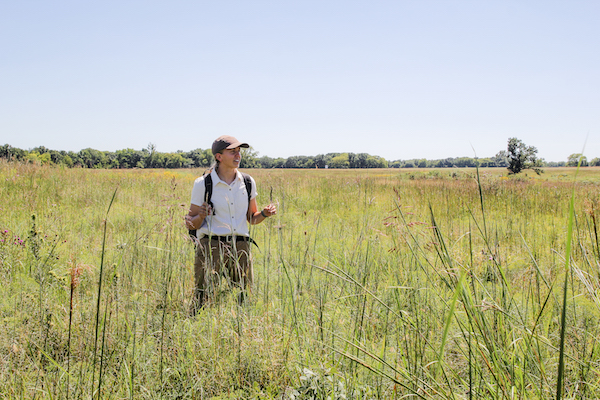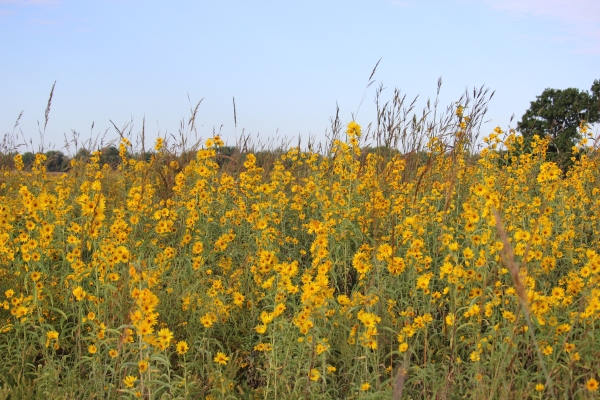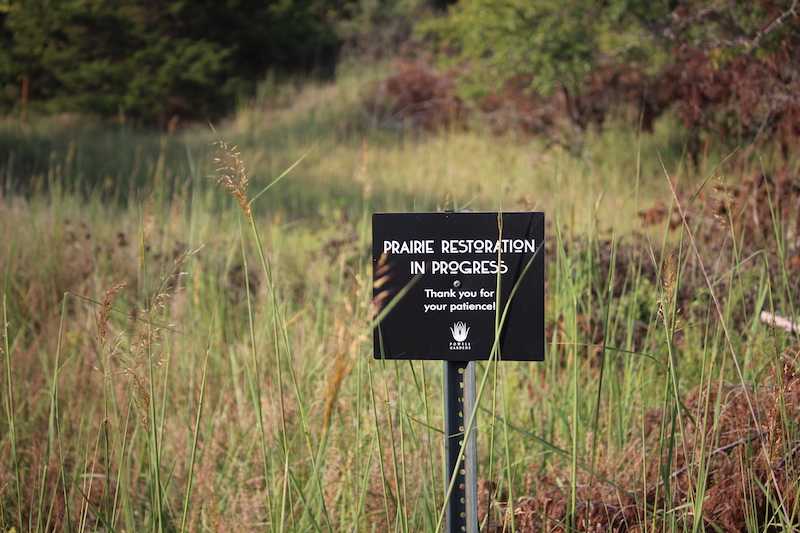Conserving the Midwest Spirit of Place
By Julie Copley, Conservationist at Powell Gardens
As a resident or visitor to the greater Kansas City region, we all share a connection to the tallgrass prairie ecosystem.
Tallgrass prairie historically comprised much of the local landscape and, as a core component to the Midwest spirit of place, is integrally woven into the fabric of the region. Yet, the tallgrass prairie landscape is under great threat and is in crucial need of conservation.
Presently, Powell Gardens is working to uphold and preserve this core component of the regional landscape for generations to come.
Tallgrass prairies: The Midwest spirit of place

Over 800 plant species can be found on prairies in Missouri, including numerous goldenrod and aster species that bloom in the fall, pictured here at the Powell Gardens Ona’s Prairie.
Temperate grasslands, such as tallgrass prairies, are North America’s most endangered ecosystem. Tallgrass prairies once covered 15 million flourishing acres in Missouri. Today, less than half of one percent of our prairie remains. Remaining tallgrass prairie is a role model of resiliency and provides the necessary tools to reconstruct lost prairie.
Prairies are robust communities with a foundation of grasses and forbs, non-woody flowering plants, and support diversity values comparable to tropical rainforest communities. Over 800 plant species can be found on prairies in Missouri, along with an abundance of animals.
From spring emergence until late in the fall, prairies support species with great variation of textures and colors throughout the year. Currently, grasses will captivate the attention of all visitors to the prairie with the intricate patterns and impressive heights of up to 8 feet. Fall on the prairie is also accented by hues of purples and yellows as many members of the aster family (Asteraceae) bloom during this season.
While fall on the prairie is defined by robust growth and height, it also supports species rich in character and complexity no more than 12 inches tall, such as native prairie orchids (Spiranthes spp.) and gentians (Gentiana spp.). Prairies are full of opportunities for discovery throughout the year.
Ona’s Prairie: A native, remnant prairie

Julie Copley, conservationist at Powell Gardens, giving a tour of Ona’s Prairie, gifted to Powell Gardens in 2019.
Ona’s Prairie, located near Sedalia, MO, is a 40-acre tallgrass prairie supporting a diversity of plant and animal species.
It was given to Powell Gardens for education and research in late 2019 as a gift from Ona Gieschen, a traveler, naturalist, and historian.
Positioned within a Conservation Opportunity Area, Ona’s Prairie is a living representative of a pre-settlement landscape in North America.
Powell Gardens is grateful for Ona’s generosity and for the generations of stewards who have preserved this special ecological community.
As one of the few remaining remnant prairies in Missouri, it is critical for prairie restoration and reconstruction efforts, including as a seed source.
“The remaining prairies in Missouri and across the tallgrass prairie ecosystem are highly fragmented communities, challenging the ability of certain species to survive. Protecting all remaining prairies is critical to the continuation of this diverse ecosystem and for countless species which depend on this habitat.”
In partnership with conservation organizations and adjacent landowners, Powell Gardens is actively managing this natural community to ensure its conservation for years to come.
Still worth preserving
Powell Gardens also stewards prairie restorations, as well as reconstructed prairies that you can witness when visiting Powell Gardens.
Restored prairies are untilled prairie landscapes receiving active stewardship, whereas reconstructed prairies are constructed from the example of remaining remnant prairies when none of the components of historical prairie, particularly the soil community, remains.
There are prairie reconstructions on display within the botanical gardens. You can also encounter prairie restorations while hiking the Prairie Ridge Trail, where our efforts are currently focused on restoring a dry prairie community to support species such as the eastern prickly pear cactus, goats rue, and others. While the trail system is closed for the remainder of the year, be sure to visit the Prairie Ridge Trail in 2024 to observe the continual progress to come.
Powell Gardens’ stewardship actions are a dynamic application of restoration strategies, including engaging valuable partners, as we work to restore the living landscape which supports our botanical gardens.
These actions include reintroducing prescribed fire across the landscape, balancing competition from invasive species, and improving biodiversity within our habitat reconstructions through thoughtful species additions.
The remaining prairies in Missouri and across the tallgrass prairie ecosystem are highly fragmented communities, challenging the ability of certain species to survive. Protecting all remaining prairies is critical to the continuation of this diverse ecosystem and for countless species which depend on this habitat.
In the prairie and beyond

Remaining tallgrass prairie, including Ona’s Prairie pictured here, is a role model of resiliency and provides the necessary tools to reconstruct lost prairie.
Powell Gardens’ conservation efforts occur in the prairie and beyond.
In 2023, staff members led and conducted prescribed fires at Powell Gardens, continued work on woody encroachment management, furthered tracking of plant populations through floristic inventories, and hosted a series of Native Prairie classes.
We also supported research through Budburst, a citizen science initiative, and participated in regal fritillary research at Ona’s Prairie conducted by the University of Central Missouri.
We can all take action
The ecosystems in our region require stewardship to maintain. We can all take action to preserve the prairie through volunteer engagement, advocating on behalf of conservation, and planting native plants in your own landscape.
Powell Gardens also offers opportunities to contribute to stewardship of natural landscapes and hiking trail maintenance through volunteer opportunities with the Conservation Crew.
For more information about prairies stewarded by Powell Gardens, the Native Prairie educational series, and Conservation Crew opportunities, visit powellgardens.org.
About Powell Gardens
As Kansas City’s botanical garden, Powell Gardens celebrates the Midwest spirit of place with display gardens, a three-mile nature trail, rotating exhibitions, architecture, and more. Established in 1988, Powell Gardens is a non-profit public garden that maintains 970 acres of lush, rolling hills and windswept meadows, with more than 175 acres and a large collection of plants open to the public for education, exploration, and recreation.
